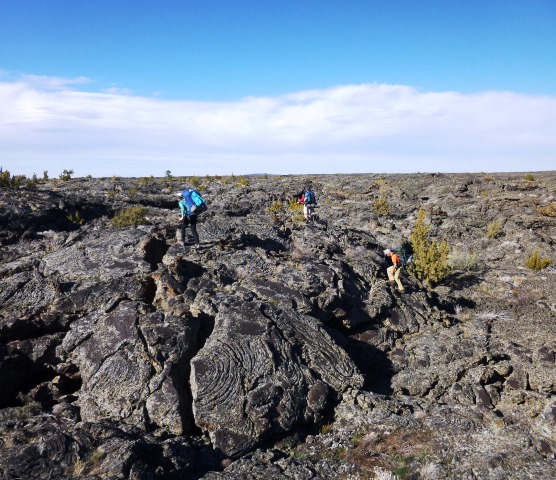|
You are viewing ARCHIVED content published online before January 20, 2025.
Please note that this content is NOT UPDATED, and links may not work. For current information,
visit https://www.nps.gov/aboutus/news/index.htm.

Contact: Ted Stout, 208-527-1330 Craters of the Moon National Monument and Preserve is composed of 3 young lava fields that spread across 500,000 acres of wild country on the Snake River Plain. Over the last 15,000 years, the lava erupted through a series of deep cracks, known collectively as the Great Rift. How does one hike across a 52-mile long volcano? On April 11, the six members of the 2014 Great Rift Expedition took up the challenge to find passage through this ocean of lava. During the next seven days they endured many hardships but also experienced the joy of discovery. Along the way, the group made many observations and discoveries. They marked the location of more than 15 newly discovered caves and observed a wide variety of flora and fauna. Although early in the season, 32 different wildflower species were observed blooming - a splash of color across the dark lava. Healthy herds of elk and pronghorn and a variety of bird species including great horned owl, sage grouse and numerous song birds were observed. Especially impressive were the kipukas, vegetated islands of older lava rock surrounded by younger lava, which serve as a refuge for native plants and animals. These areas also provided refuge for the weary "rifters" as they sought out a place to rest in the evenings. Fifty years ago, in a nearly unanimous vote, Congress enacted landmark legislation that permanently protected some of the most undisturbed places in America. The Wilderness Act identified wilderness as "an area where the earth and its community of life are untrammeled by man, where man himself is a visitor who does not remain". This definition accurately describes a large portion of Craters of the Moon where in 1970 Congress designated the first wilderness area in any national park unit. Expansion of the Monument in 2000 included another 495,000 acres of adjoining lands already determined by the Bureau of Land Management to be worthy of wilderness designation. "To stand and gaze with amazement mingled with fear at things of which the world knows nothing…passing alone through volcanic craters…crossing miles of folds of rock similar to the folds of a huge blanket was indeed an experience never to be forgotten." More photos of the expedition, including a map of the route, are available at the following link:https://www.flickr.com/photos/cratersofthemoonnps/sets/72157644237886233/
|
Last updated: February 28, 2015
